Network Working Group M. Luby
Request for Comments: 5053 Digital Fountain
Category: Standards Track A. Shokrollahi
EPFL
M. Watson
Digital Fountain
T. Stockhammer
Nomor Research
October 2007
Raptor Forward Error Correction Scheme for Object Delivery
Status of This Memo
This document specifies an Internet standards track protocol for the
Internet community, and requests discussion and suggestions for
improvements. Please refer to the current edition of the "Internet
Official Protocol Standards" (STD 1) for the standardization state
and status of this protocol. Distribution of this memo is unlimited.
Abstract
This document describes a Fully-Specified Forward Error Correction
(FEC) scheme, corresponding to FEC Encoding ID 1, for the Raptor
forward error correction code and its application to reliable
delivery of data objects.
Raptor is a fountain code, i.e., as many encoding symbols as needed
can be generated by the encoder on-the-fly from the source symbols of
a source block of data. The decoder is able to recover the source
block from any set of encoding symbols only slightly more in number
than the number of source symbols.
The Raptor code described here is a systematic code, meaning that all
the source symbols are among the encoding symbols that can be
generated.
Luby, et al. Standards Track [Page 1]
�
RFC 5053 Raptor FEC Scheme October 2007
Table of Contents
1. Introduction . . . . . . . . . . . . . . . . . . . . . . . . . 3
2. Requirements Notation . . . . . . . . . . . . . . . . . . . . 3
3. Formats and Codes . . . . . . . . . . . . . . . . . . . . . . 3
3.1. FEC Payload IDs . . . . . . . . . . . . . . . . . . . . . 3
3.2. FEC Object Transmission Information (OTI) . . . . . . . . 4
3.2.1. Mandatory . . . . . . . . . . . . . . . . . . . . . . 4
3.2.2. Common . . . . . . . . . . . . . . . . . . . . . . . . 4
3.2.3. Scheme-Specific . . . . . . . . . . . . . . . . . . . 5
4. Procedures . . . . . . . . . . . . . . . . . . . . . . . . . . 5
4.1. Content Delivery Protocol Requirements . . . . . . . . . . 5
4.2. Example Parameter Derivation Algorithm . . . . . . . . . . 6
5. Raptor FEC Code Specification . . . . . . . . . . . . . . . . 8
5.1. Definitions, Symbols, and Abbreviations . . . . . . . . . 8
5.1.1. Definitions . . . . . . . . . . . . . . . . . . . . . 8
5.1.2. Symbols . . . . . . . . . . . . . . . . . . . . . . . 9
5.1.3. Abbreviations . . . . . . . . . . . . . . . . . . . . 11
5.2. Overview . . . . . . . . . . . . . . . . . . . . . . . . . 11
5.3. Object Delivery . . . . . . . . . . . . . . . . . . . . . 12
5.3.1. Source Block Construction . . . . . . . . . . . . . . 12
5.3.2. Encoding Packet Construction . . . . . . . . . . . . . 14
5.4. Systematic Raptor Encoder . . . . . . . . . . . . . . . . 15
5.4.1. Encoding Overview . . . . . . . . . . . . . . . . . . 15
5.4.2. First Encoding Step: Intermediate Symbol Generation . 16
5.4.3. Second Encoding Step: LT Encoding . . . . . . . . . . 20
5.4.4. Generators . . . . . . . . . . . . . . . . . . . . . . 21
5.5. Example FEC Decoder . . . . . . . . . . . . . . . . . . . 23
5.5.1. General . . . . . . . . . . . . . . . . . . . . . . . 23
5.5.2. Decoding a Source Block . . . . . . . . . . . . . . . 23
5.6. Random Numbers . . . . . . . . . . . . . . . . . . . . . . 28
5.6.1. The Table V0 . . . . . . . . . . . . . . . . . . . . . 28
5.6.2. The Table V1 . . . . . . . . . . . . . . . . . . . . . 29
5.7. Systematic Indices J(K) . . . . . . . . . . . . . . . . . 30
6. Security Considerations . . . . . . . . . . . . . . . . . . . 43
7. IANA Considerations . . . . . . . . . . . . . . . . . . . . . 43
8. Acknowledgements . . . . . . . . . . . . . . . . . . . . . . . 44
9. References . . . . . . . . . . . . . . . . . . . . . . . . . . 44
9.1. Normative References . . . . . . . . . . . . . . . . . . . 44
9.2. Informative References . . . . . . . . . . . . . . . . . . 44
Luby, et al. Standards Track [Page 2]
�
RFC 5053 Raptor FEC Scheme October 2007
1. Introduction
This document specifies an FEC Scheme for the Raptor forward error
correction code for object delivery applications. The concept of an
FEC Scheme is defined in [RFC5052] and this document follows the
format prescribed there and uses the terminology of that document.
Raptor Codes were introduced in [Raptor]. For an overview, see, for
example, [CCNC].
The Raptor FEC Scheme is a Fully-Specified FEC Scheme corresponding
to FEC Encoding ID 1.
Raptor is a fountain code, i.e., as many encoding symbols as needed
can be generated by the encoder on-the-fly from the source symbols of
a block. The decoder is able to recover the source block from any
set of encoding symbols only slightly more in number than the number
of source symbols.
The code described in this document is a systematic code, that is,
the original source symbols can be sent unmodified from sender to
receiver, as well as a number of repair symbols. For more background
on the use of Forward Error Correction codes in reliable multicast,
see [RFC3453].
The code described here is identical to that described in [MBMS].
2. Requirements Notation
The key words "MUST", "MUST NOT", "REQUIRED", "SHALL", "SHALL NOT",
"SHOULD", "SHOULD NOT", "RECOMMENDED", "MAY", and "OPTIONAL" in this
document are to be interpreted as described in [RFC2119].
3. Formats and Codes
3.1. FEC Payload IDs
The FEC Payload ID MUST be a 4 octet field defined as follows:
0 1 2 3
0 1 2 3 4 5 6 7 8 9 0 1 2 3 4 5 6 7 8 9 0 1 2 3 4 5 6 7 8 9 0 1
+-+-+-+-+-+-+-+-+-+-+-+-+-+-+-+-+-+-+-+-+-+-+-+-+-+-+-+-+-+-+-+-+
| Source Block Number | Encoding Symbol ID |
+-+-+-+-+-+-+-+-+-+-+-+-+-+-+-+-+-+-+-+-+-+-+-+-+-+-+-+-+-+-+-+-+
Figure 1: FEC Payload ID format
Luby, et al. Standards Track [Page 3]
�
RFC 5053 Raptor FEC Scheme October 2007
Source Block Number (SBN), (16 bits): An integer identifier for
the source block that the encoding symbols within the packet
relate to.
Encoding Symbol ID (ESI), (16 bits): An integer identifier for the
encoding symbols within the packet.
The interpretation of the Source Block Number and Encoding Symbol
Identifier is defined in Section 5.
3.2. FEC Object Transmission Information (OTI)
3.2.1. Mandatory
The value of the FEC Encoding ID MUST be 1 (one), as assigned by IANA
(see Section 7).
3.2.2. Common
The Common FEC Object Transmission Information elements used by this
FEC Scheme are:
- Transfer Length (F)
- Encoding Symbol Length (T)
The Transfer Length is a non-negative integer less than 2^^45. The
Encoding Symbol Length is a non-negative integer less than 2^^16.
The encoded Common FEC Object Transmission Information format is
shown in Figure 2.
0 1 2 3
0 1 2 3 4 5 6 7 8 9 0 1 2 3 4 5 6 7 8 9 0 1 2 3 4 5 6 7 8 9 0 1
+-+-+-+-+-+-+-+-+-+-+-+-+-+-+-+-+-+-+-+-+-+-+-+-+-+-+-+-+-+-+-+-+
| Transfer Length |
+ +-+-+-+-+-+-+-+-+-+-+-+-+-+-+-+-+
| | Reserved |
+-+-+-+-+-+-+-+-+-+-+-+-+-+-+-+-+-+-+-+-+-+-+-+-+-+-+-+-+-+-+-+-+
| Encoding Symbol Length |
+-+-+-+-+-+-+-+-+-+-+-+-+-+-+-+-+
Figure 2: Encoded Common FEC OTI for Raptor FEC Scheme
NOTE 1: The limit of 2^^45 on the transfer length is a consequence
of the limitation on the symbol size to 2^^16-1, the limitation on
the number of symbols in a source block to 2^^13, and the
Luby, et al. Standards Track [Page 4]
�
RFC 5053 Raptor FEC Scheme October 2007
limitation on the number of source blocks to 2^^16. However, the
Transfer Length is encoded as a 48-bit field for simplicity.
3.2.3. Scheme-Specific
The following parameters are carried in the Scheme-Specific FEC
Object Transmission Information element for this FEC Scheme:
- The number of source blocks (Z)
- The number of sub-blocks (N)
- A symbol alignment parameter (Al)
These parameters are all non-negative integers. The encoded Scheme-
specific Object Transmission Information is a 4-octet field
consisting of the parameters Z (2 octets), N (1 octet), and Al (1
octet) as shown in Figure 3.
0 1 2 3
0 1 2 3 4 5 6 7 8 9 0 1 2 3 4 5 6 7 8 9 0 1 2 3 4 5 6 7 8 9 0 1
+-+-+-+-+-+-+-+-+-+-+-+-+-+-+-+-+-+-+-+-+-+-+-+-+-+-+-+-+-+-+-+-+
| Z | N | Al |
+-+-+-+-+-+-+-+-+-+-+-+-+-+-+-+-+-+-+-+-+-+-+-+-+-+-+-+-+-+-+-+-+
Figure 3: Encoded Scheme-Specific FEC Object Transmission Information
The encoded FEC Object Transmission Information is a 14-octet field
consisting of the concatenation of the encoded Common FEC Object
Transmission Information and the encoded Scheme-Specific FEC Object
Transmission Information.
These three parameters define the source block partitioning as
described in Section 5.3.1.2.
4. Procedures
4.1. Content Delivery Protocol Requirements
This section describes the information exchange between the Raptor
FEC Scheme and any Content Delivery Protocol (CDP) that makes use of
the Raptor FEC Scheme for object delivery.
The Raptor encoder and decoder for object delivery require the
following information from the CDP:
- The transfer length of the object, F, in bytes
Luby, et al. Standards Track [Page 5]
�
RFC 5053 Raptor FEC Scheme October 2007
- A symbol alignment parameter, Al
- The symbol size, T, in bytes, which MUST be a multiple of Al
- The number of source blocks, Z
- The number of sub-blocks in each source block, N
The Raptor encoder for object delivery additionally requires:
- the object to be encoded, F bytes
The Raptor encoder supplies the CDP with the following information
for each packet to be sent:
- Source Block Number (SBN)
- Encoding Symbol ID (ESI)
- Encoding symbol(s)
The CDP MUST communicate this information to the receiver.
4.2. Example Parameter Derivation Algorithm
This section provides recommendations for the derivation of the three
transport parameters, T, Z, and N. This recommendation is based on
the following input parameters:
- F the transfer length of the object, in bytes
- W a target on the sub-block size, in bytes
- P the maximum packet payload size, in bytes, which is assumed to
be a multiple of Al
- Al the symbol alignment parameter, in bytes
- Kmax the maximum number of source symbols per source block.
Note: Section 5.1.2 defines Kmax to be 8192.
- Kmin a minimum target on the number of symbols per source block
- Gmax a maximum target number of symbols per packet
Luby, et al. Standards Track [Page 6]
�
RFC 5053 Raptor FEC Scheme October 2007
Based on the above inputs, the transport parameters T, Z, and N are
calculated as follows:
Let
G = min{ceil(P*Kmin/F), P/Al, Gmax}
T = floor(P/(Al*G))*Al
Kt = ceil(F/T)
Z = ceil(Kt/Kmax)
N = min{ceil(ceil(Kt/Z)*T/W), T/Al}
The value G represents the maximum number of symbols to be
transported in a single packet. The value Kt is the total number of
symbols required to represent the source data of the object. The
values of G and N derived above should be considered as lower bounds.
It may be advantageous to increase these values, for example, to the
nearest power of two. In particular, the above algorithm does not
guarantee that the symbol size, T, divides the maximum packet size,
P, and so it may not be possible to use the packets of size exactly
P. If, instead, G is chosen to be a value that divides P/Al, then
the symbol size, T, will be a divisor of P and packets of size P can
be used.
The algorithm above and that defined in Section 5.3.1.2 ensure that
the sub-symbol sizes are a multiple of the symbol alignment
parameter, Al. This is useful because the XOR operations used for
encoding and decoding are generally performed several bytes at a
time, for example, at least 4 bytes at a time on a 32-bit processor.
Thus, the encoding and decoding can be performed faster if the sub-
symbol sizes are a multiple of this number of bytes.
Recommended settings for the input parameters, Al, Kmin, and Gmax are
as follows: Al = 4, Kmin = 1024, Gmax = 10.
The parameter W can be used to generate encoded data that can be
decoded efficiently with limited working memory at the decoder. Note
that the actual maximum decoder memory requirement for a given value
of W depends on the implementation, but it is possible to implement
decoding using working memory only slightly larger than W.
Luby, et al. Standards Track [Page 7]
�
RFC 5053 Raptor FEC Scheme October 2007
5. Raptor FEC Code Specification
5.1. Definitions, Symbols, and Abbreviations
5.1.1. Definitions
For the purposes of this specification, the following terms and
definitions apply.
Source block: a block of K source symbols that are considered
together for Raptor encoding purposes.
Source symbol: the smallest unit of data used during the encoding
process. All source symbols within a source block have the same
size.
Encoding symbol: a symbol that is included in a data packet. The
encoding symbols consist of the source symbols and the repair
symbols. Repair symbols generated from a source block have the
same size as the source symbols of that source block.
Systematic code: a code in which all the source symbols may be
included as part of the encoding symbols sent for a source block.
Repair symbol: the encoding symbols sent for a source block that
are not the source symbols. The repair symbols are generated
based on the source symbols.
Intermediate symbols: symbols generated from the source symbols
using an inverse encoding process . The repair symbols are then
generated directly from the intermediate symbols. The encoding
symbols do not include the intermediate symbols, i.e.,
intermediate symbols are not included in data packets.
Symbol: a unit of data. The size, in bytes, of a symbol is known
as the symbol size.
Encoding symbol group: a group of encoding symbols that are sent
together, i.e., within the same packet whose relationship to the
source symbols can be derived from a single Encoding Symbol ID.
Encoding Symbol ID: information that defines the relationship
between the symbols of an encoding symbol group and the source
symbols.
Encoding packet: data packets that contain encoding symbols
Luby, et al. Standards Track [Page 8]
�
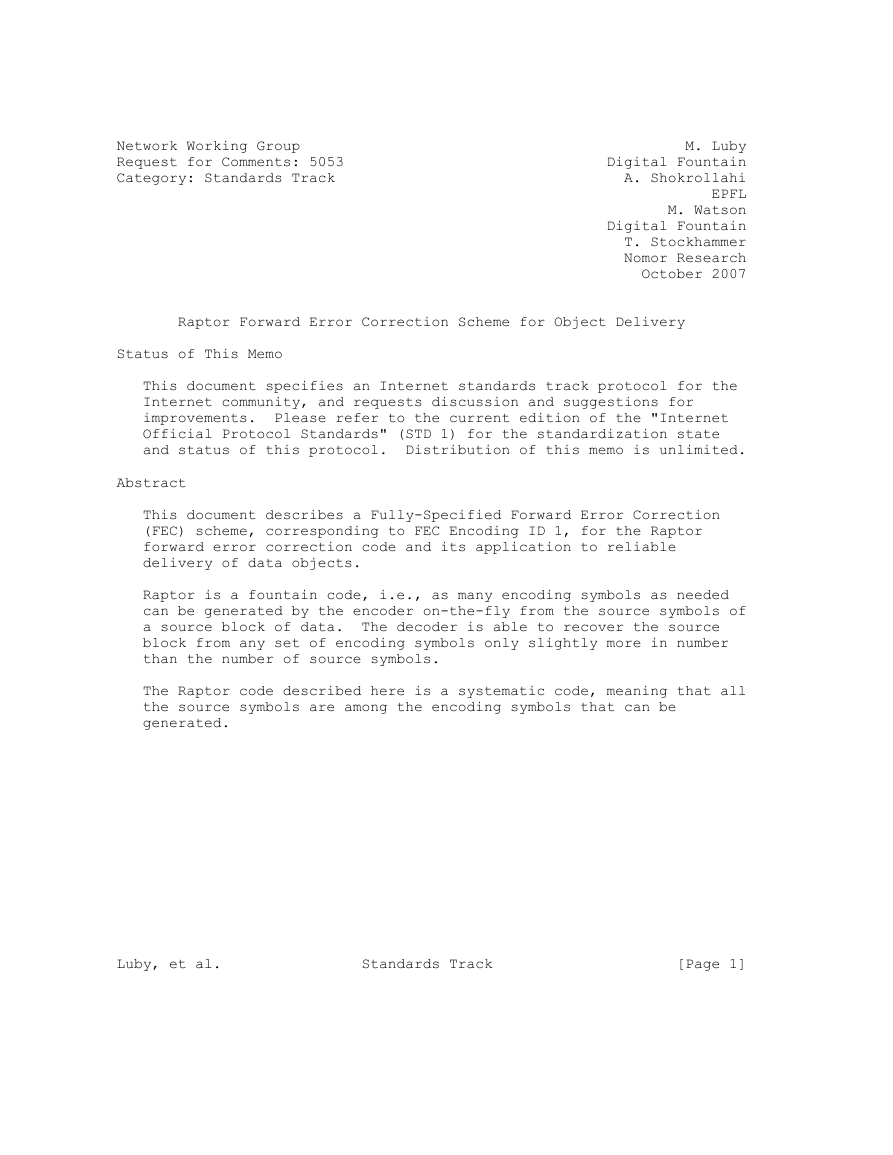
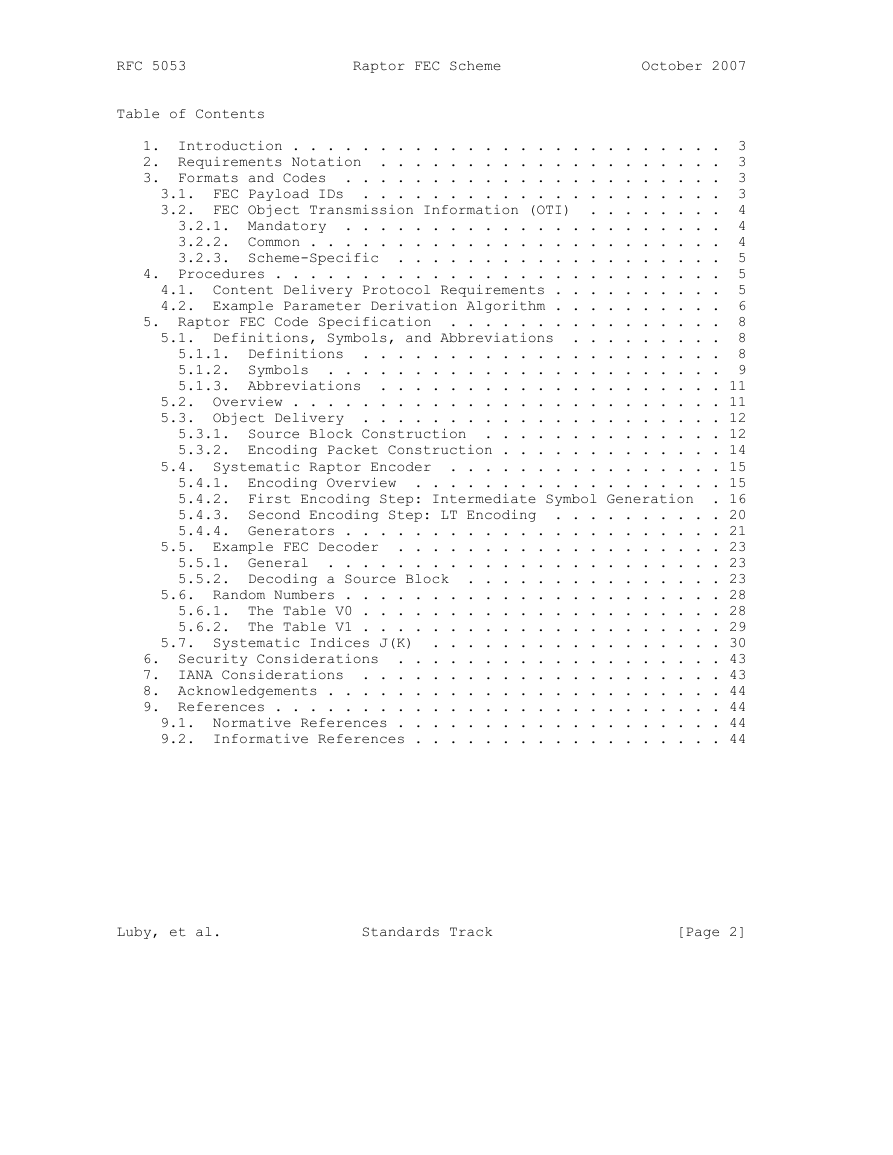
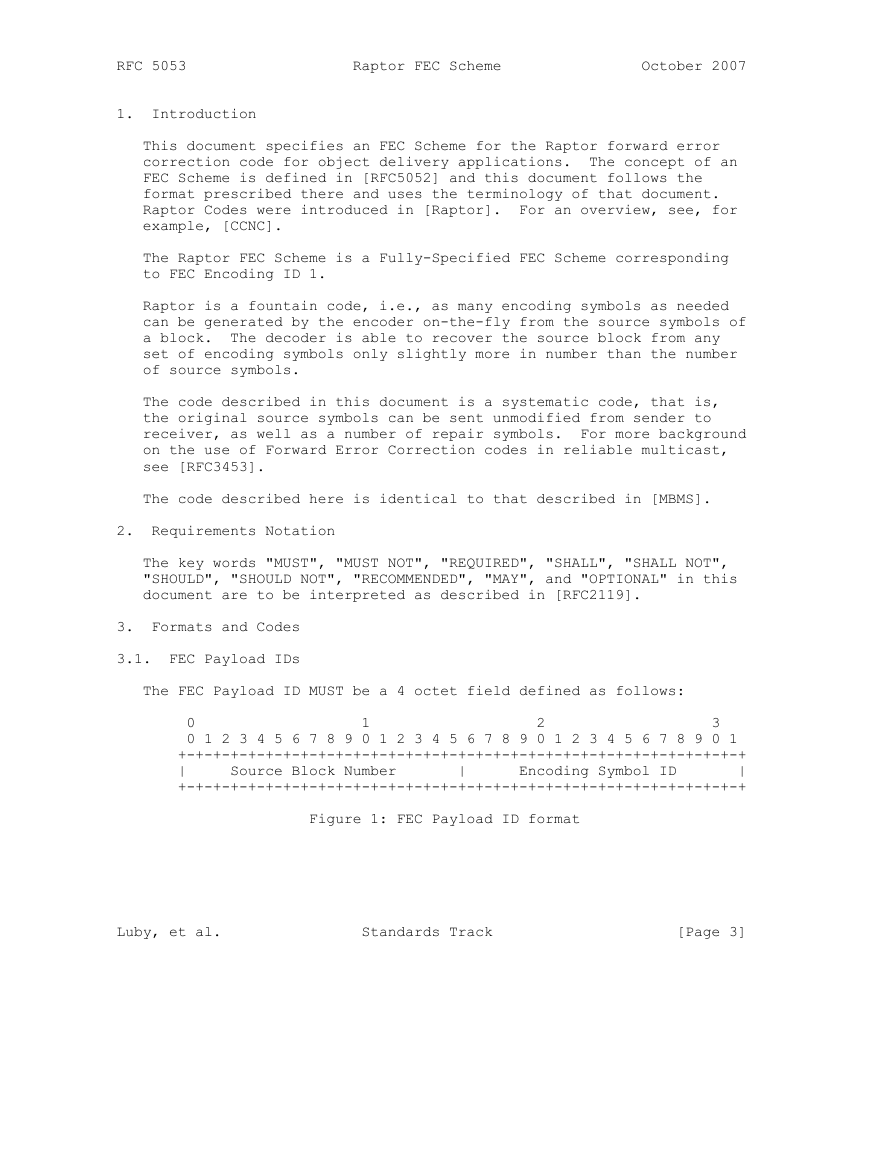
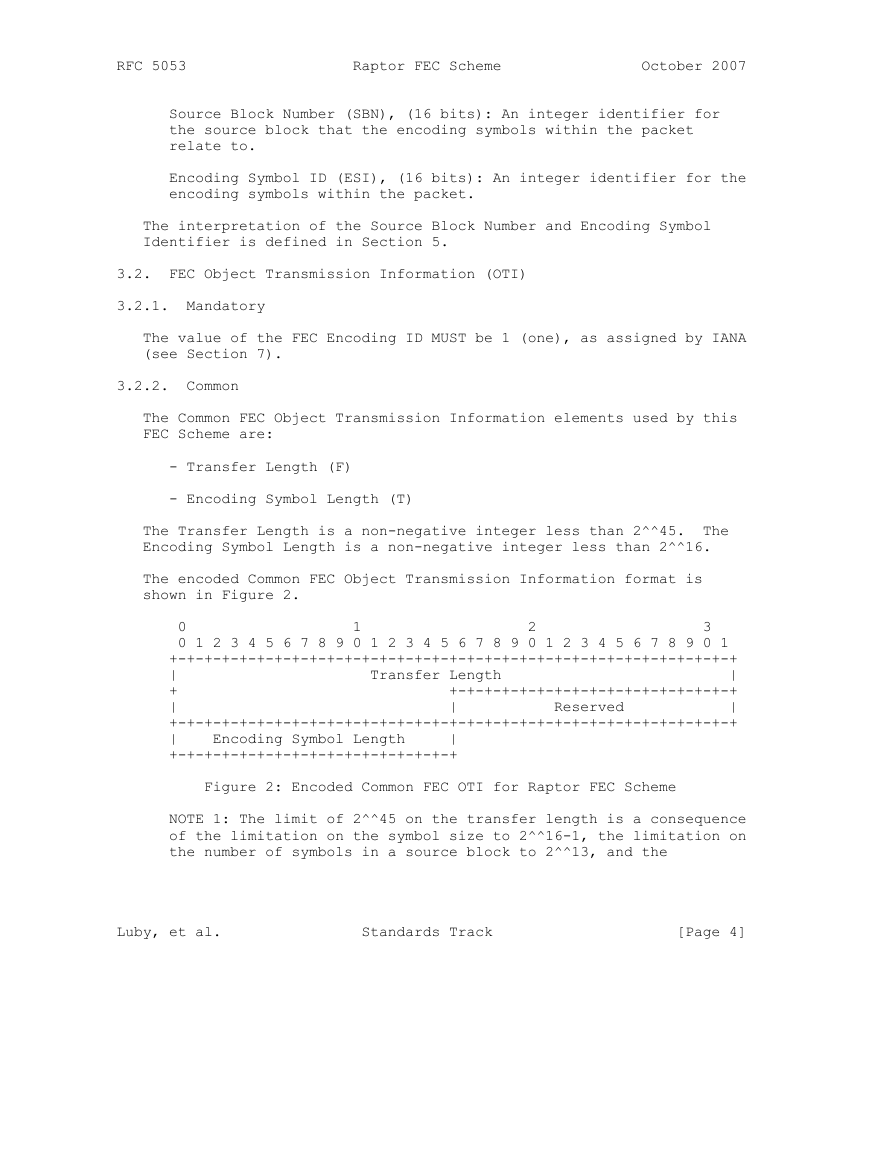
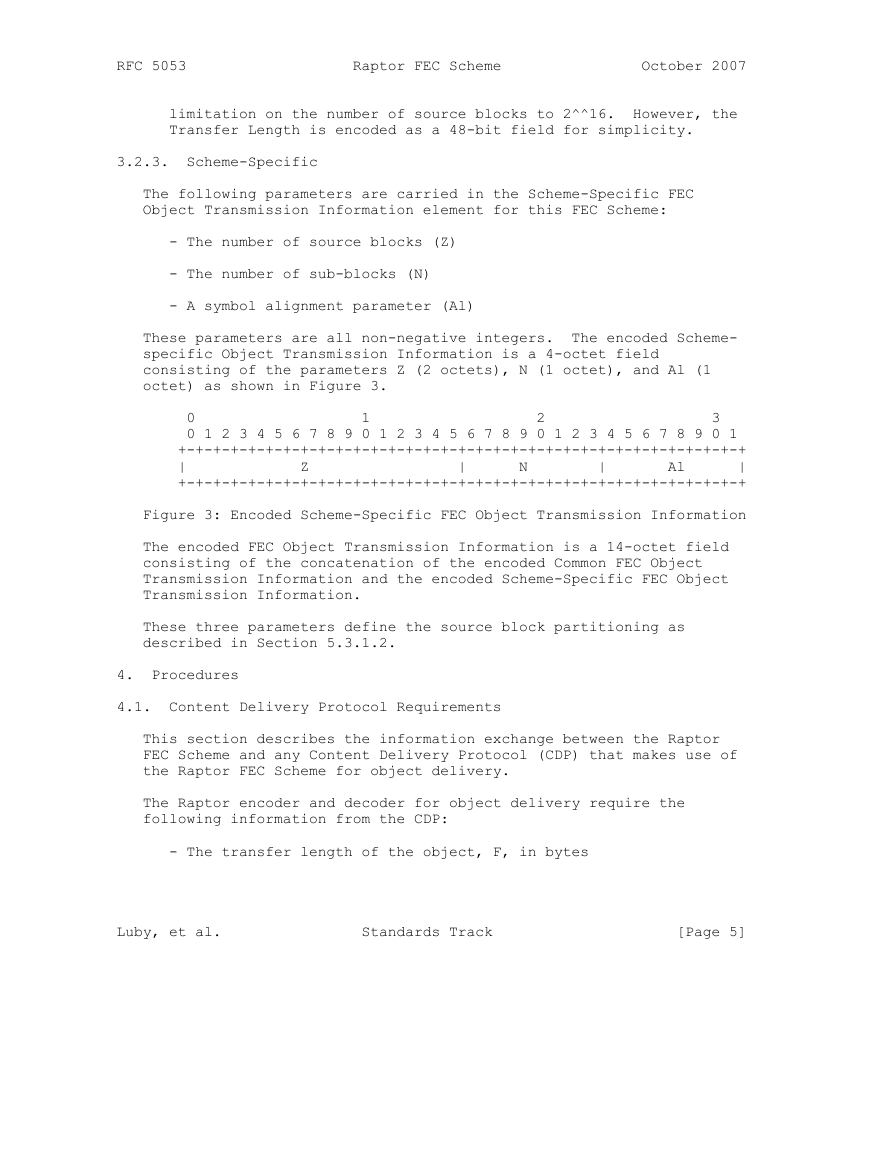

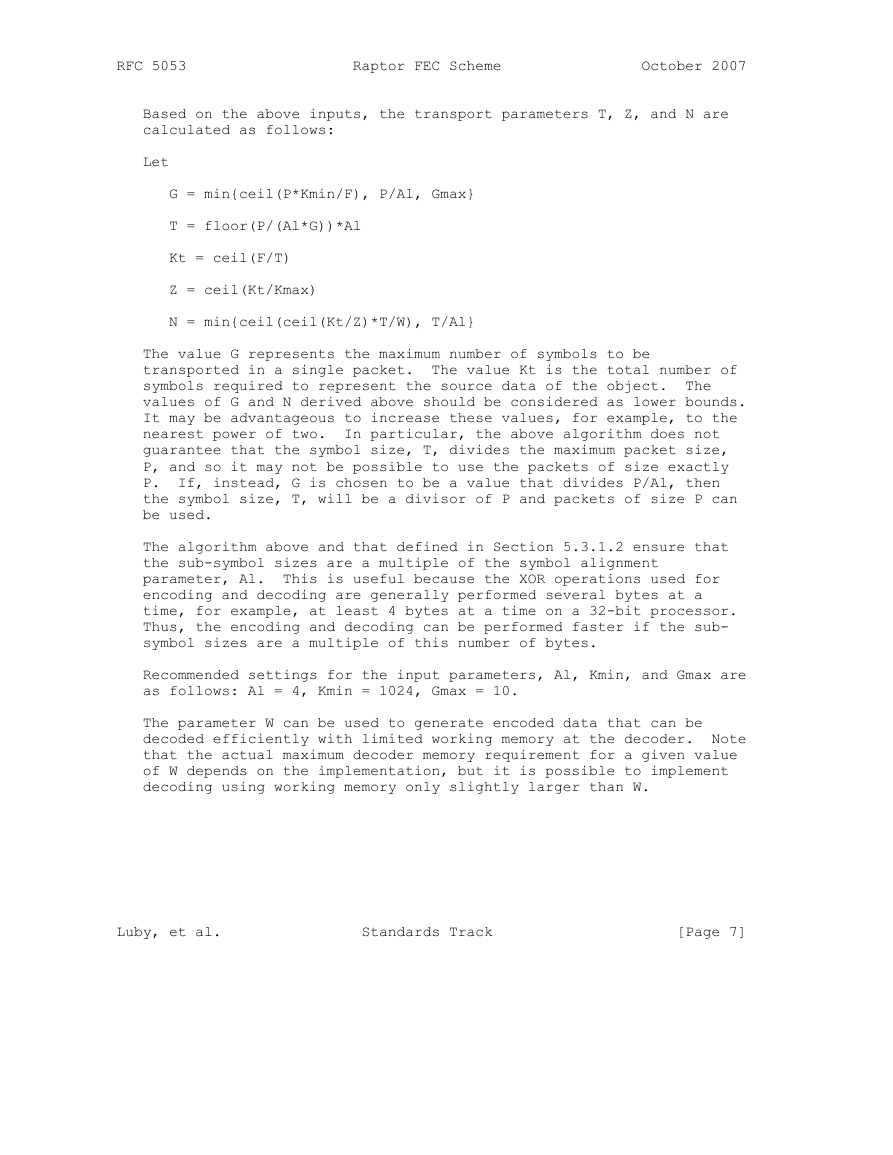
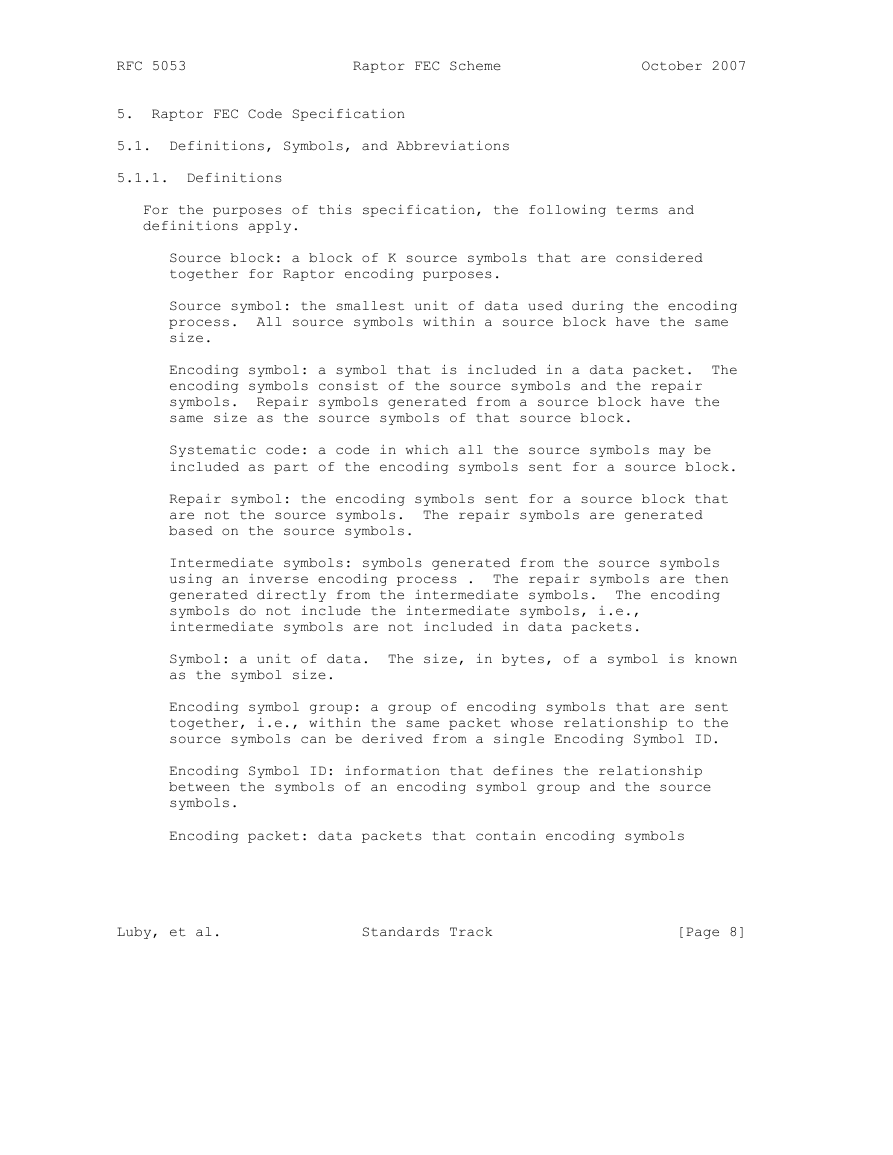








 2023年江西萍乡中考道德与法治真题及答案.doc
2023年江西萍乡中考道德与法治真题及答案.doc 2012年重庆南川中考生物真题及答案.doc
2012年重庆南川中考生物真题及答案.doc 2013年江西师范大学地理学综合及文艺理论基础考研真题.doc
2013年江西师范大学地理学综合及文艺理论基础考研真题.doc 2020年四川甘孜小升初语文真题及答案I卷.doc
2020年四川甘孜小升初语文真题及答案I卷.doc 2020年注册岩土工程师专业基础考试真题及答案.doc
2020年注册岩土工程师专业基础考试真题及答案.doc 2023-2024学年福建省厦门市九年级上学期数学月考试题及答案.doc
2023-2024学年福建省厦门市九年级上学期数学月考试题及答案.doc 2021-2022学年辽宁省沈阳市大东区九年级上学期语文期末试题及答案.doc
2021-2022学年辽宁省沈阳市大东区九年级上学期语文期末试题及答案.doc 2022-2023学年北京东城区初三第一学期物理期末试卷及答案.doc
2022-2023学年北京东城区初三第一学期物理期末试卷及答案.doc 2018上半年江西教师资格初中地理学科知识与教学能力真题及答案.doc
2018上半年江西教师资格初中地理学科知识与教学能力真题及答案.doc 2012年河北国家公务员申论考试真题及答案-省级.doc
2012年河北国家公务员申论考试真题及答案-省级.doc 2020-2021学年江苏省扬州市江都区邵樊片九年级上学期数学第一次质量检测试题及答案.doc
2020-2021学年江苏省扬州市江都区邵樊片九年级上学期数学第一次质量检测试题及答案.doc 2022下半年黑龙江教师资格证中学综合素质真题及答案.doc
2022下半年黑龙江教师资格证中学综合素质真题及答案.doc